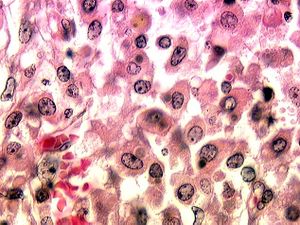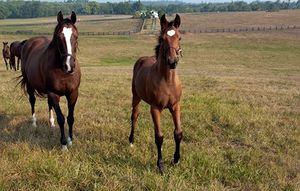Rhodococcus equi: Difference between revisions
No edit summary |
No edit summary |
||
| Line 11: | Line 11: | ||
==Description and Significance== | ==Description and Significance== | ||
''Rhodococcus equi'', originally discovered in horses by Magnusson, is a pathogen that is known to be able to affect animals and humans [[#References | [4]]]. ''R. equi'' is a gram-positive coccobacillus that has the ability of producing a red pigment. It is a non-motile bacteria from the phylum Actinobacteria that is also aerobic and non-sporulating [[#References | [1]]]. ''R. equi'' is able to utilize carbon efficiently and is therefore important to the recycling of carbon in the soil [[#References | [ | ''Rhodococcus equi'', originally discovered in horses by Magnusson, is a pathogen that is known to be able to affect animals and humans [[#References | [4]]]. ''R. equi'' is a gram-positive coccobacillus that has the ability of producing a red pigment. It is a non-motile bacteria from the phylum Actinobacteria that is also aerobic and non-sporulating [[#References | [1]]]. ''R. equi'' is able to utilize carbon efficiently and is therefore important to the recycling of carbon in the soil [[#References | [5]]]. Up until 1983, this bacteria was mostly found to infect animals such as horses and foals [[#References | [1]]]. Now there are more cases being seen in humans, especially those who are immunocompromised such as patients with AIDS [[#References | [5]]]. ''R. equi'' generally leads to subacute or chronic bronchopneumonia which can lead to mortality, especially if not treated in the early stages [[#References | [3]]][[#References | [1]]]. Infections due to ''R. equi'' currently have a mortality rate of approximately 25% [[#References | [1]]]. | ||
==Structure, Metabolism, and Life Cycle== | ==Structure, Metabolism, and Life Cycle== | ||
The ''Rhodococcus equi'' thrives on volatile organic acids, such as those found in manure [[#References | [3]]]. Its cell envelope consists of mycolic acids, polysaccharides, and glycolipids that form around a unique periplasmic space [[#References | [3]]]. This envelope is special because it is different from other gram-negative and gram-positive bacteria. It has a strong wall that acts as a barrier for hydrophilc molecules, but contains porins within the cell wall that help bring in the necessary molecules for life [[#References | [3]]]. It has been speculated that due to the mycolic acids in the cell wall, ''R. equi'' is able to resist many kinds of environmental stresses such as less available oxygen or high acidity [[#References | [3]]]. | The ''Rhodococcus equi'' thrives on volatile organic acids, such as those found in manure [[#References | [3]]]. Its cell envelope consists of mycolic acids, polysaccharides, and glycolipids that form around a unique periplasmic space [[#References | [3]]]. This envelope is special because it is different from other gram-negative and gram-positive bacteria. It has a strong wall that acts as a barrier for hydrophilc molecules, but contains porins within the cell wall that help bring in the necessary molecules for life [[#References | [3]]]. It has been speculated that due to the mycolic acids in the cell wall, ''R. equi'' is able to resist many kinds of environmental stresses such as less available oxygen or high acidity [[#References | [3]]]. ''R. equi'' is able to degrade a wide variety of aromatic compounds [[#References | [4]]]. what important molecules it produces (if any), does it have an interesting life cycle? | ||
[[File: foal r. equi.jpg|thumb|left|Foals can contract deadly pneumonia from ''R. equi''. (Photo: Anne M. Eberhardt)]] | [[File: foal r. equi.jpg|thumb|left|Foals can contract deadly pneumonia from ''R. equi''. (Photo: Anne M. Eberhardt)]] | ||
| Line 29: | Line 29: | ||
[3] Meijer, W.G., Prescott, John F. 2004. "''Rhodococcus equi''". ''Veterinary Research-A Journal on Animal Infection and Epidemiology (35)'': 383-396. http://www.vetres-archive.org/file/Vet.Res._0928-4249_2004_35_4/Vet.Res._0928-4249_2004_35_4_ART0002.pdf | [3] Meijer, W.G., Prescott, John F. 2004. "''Rhodococcus equi''". ''Veterinary Research-A Journal on Animal Infection and Epidemiology (35)'': 383-396. http://www.vetres-archive.org/file/Vet.Res._0928-4249_2004_35_4/Vet.Res._0928-4249_2004_35_4_ART0002.pdf | ||
[4] Prescott, John F. 1991. "''Rhodococcus Equi'': an Animal and Human Pathogen." ''Clinical Microbiology Reviews. 4 (1)'': 20-34. http://www.ncbi.nlm.nih.gov/pmc/articles/PMC358176/pdf/cmr00042-0036.pdf | [4] Navarro-Llorens, Juana M. et al. 2005. "Phenylacetate Catabolism in Rhodococcus sp. Strain RHA1: a Central Pathway for Degradation of Aromatic Compounds." ''Journal of Bacteriology (187)'': 4497-4504. http://jb.asm.org/content/187/13/4497.full | ||
[5] Prescott, John F. 1991. "''Rhodococcus Equi'': an Animal and Human Pathogen." ''Clinical Microbiology Reviews. 4 (1)'': 20-34. http://www.ncbi.nlm.nih.gov/pmc/articles/PMC358176/pdf/cmr00042-0036.pdf | |||
Revision as of 02:36, 22 July 2013
Classification
Bacteria/Actinobacteria/Actinobacteria; Actinobacteridae; Actinomycetales; Corynebacterineae; Nocardiaceae
Genus Species
Rhodococcus; Rhodococcus equi

]
Description and Significance
Rhodococcus equi, originally discovered in horses by Magnusson, is a pathogen that is known to be able to affect animals and humans [4]. R. equi is a gram-positive coccobacillus that has the ability of producing a red pigment. It is a non-motile bacteria from the phylum Actinobacteria that is also aerobic and non-sporulating [1]. R. equi is able to utilize carbon efficiently and is therefore important to the recycling of carbon in the soil [5]. Up until 1983, this bacteria was mostly found to infect animals such as horses and foals [1]. Now there are more cases being seen in humans, especially those who are immunocompromised such as patients with AIDS [5]. R. equi generally leads to subacute or chronic bronchopneumonia which can lead to mortality, especially if not treated in the early stages [3] [1]. Infections due to R. equi currently have a mortality rate of approximately 25% [1].
Structure, Metabolism, and Life Cycle
The Rhodococcus equi thrives on volatile organic acids, such as those found in manure [3]. Its cell envelope consists of mycolic acids, polysaccharides, and glycolipids that form around a unique periplasmic space [3]. This envelope is special because it is different from other gram-negative and gram-positive bacteria. It has a strong wall that acts as a barrier for hydrophilc molecules, but contains porins within the cell wall that help bring in the necessary molecules for life [3]. It has been speculated that due to the mycolic acids in the cell wall, R. equi is able to resist many kinds of environmental stresses such as less available oxygen or high acidity [3]. R. equi is able to degrade a wide variety of aromatic compounds [4]. what important molecules it produces (if any), does it have an interesting life cycle?
Ecology and Pathogenesis
Natural habitat (soil, water, commensal of humans or animals?)
If relevant, how does this organism cause disease? Human, animal, or plant hosts? Important virulence factors, as well as patient symptoms.
References
[1] Kedlaya, Indira. 2013. "Rhodococcus equi". Medscape Reference: Drugs, Diseases and Pathogens. http://emedicine.medscape.com/article/235466-overview
[2] Kulich, Scott M., Pasculle, William A. 1998. "Final Diagnosis--Pneumonia, Hilar Lymphadenitis and Sepsis Secondary to Rhodococcus equi." UPMC Department of Pathology. http://path.upmc.edu/cases/case146/dx.html
[3] Meijer, W.G., Prescott, John F. 2004. "Rhodococcus equi". Veterinary Research-A Journal on Animal Infection and Epidemiology (35): 383-396. http://www.vetres-archive.org/file/Vet.Res._0928-4249_2004_35_4/Vet.Res._0928-4249_2004_35_4_ART0002.pdf
[4] Navarro-Llorens, Juana M. et al. 2005. "Phenylacetate Catabolism in Rhodococcus sp. Strain RHA1: a Central Pathway for Degradation of Aromatic Compounds." Journal of Bacteriology (187): 4497-4504. http://jb.asm.org/content/187/13/4497.full
[5] Prescott, John F. 1991. "Rhodococcus Equi: an Animal and Human Pathogen." Clinical Microbiology Reviews. 4 (1): 20-34. http://www.ncbi.nlm.nih.gov/pmc/articles/PMC358176/pdf/cmr00042-0036.pdf
Author
Page authored by Mattie Hogg, student of Mandy Brosnahan, Instructor at the University of Minnesota-Twin Cities, MICB 3301/3303: Biology of Microorganisms.

